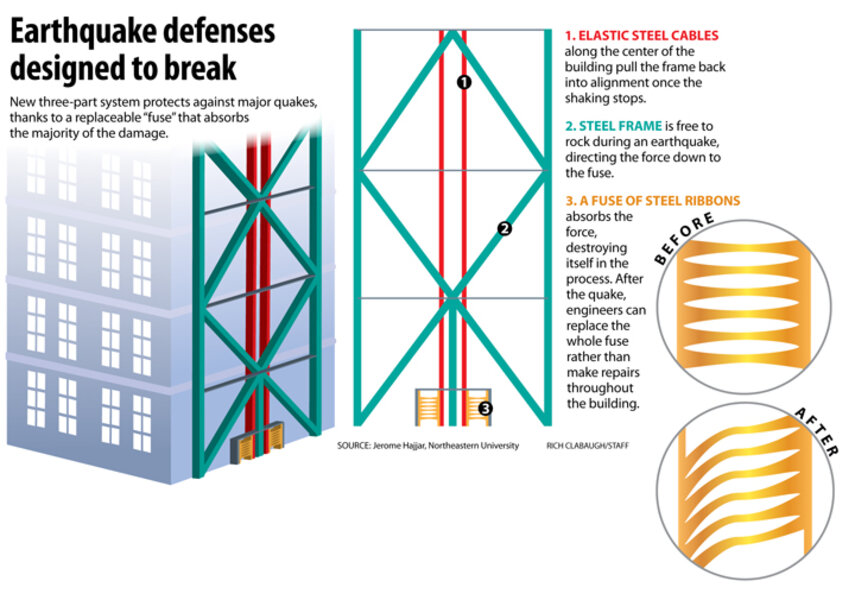To save buildings from quakes, architects try self-destruction by design
Loading...
Earthquake building codes aren't really designed to save buildings. Engineers need to protect occupants, but there's no rule that buildings should withstand earthquakes of any particular magnitude.
"Perfectly good buildings may need to be condemned after an earthquake, simply because that's how we're designing them – because we think that's economical," says Jerome Hajjar, chair of the Department of Civil and Environmental Engineering at Northeastern University in Boston.
Dr. Hajjar and his team think earthquake engineers can do better. They developed a new method for defending buildings not just from collapse, but also from the tiny fractures and warps that make structures unsafe after a quake and very expensive to repair.
Their secret: self-destruction by design.
The scheme directs the force of an earthquake to a "fuse" that sacrifices itself to save the rest of the building. The seismic force irrevocably destroys the steel fuse. But since the damage is contained to only one part of the building, engineers can simply remove the ruined fuse and replace it with another.
The fuse itself is a sheet of high-caliber steel with diamond shapes cut out of the center. These holes turn the plate into powerful ribbons that writhe under extreme force, absorbing the impact. (See graphic.)
Fuses are not new to earthquake engineering. Some builders install protective braces that warp and wear as the structure shakes. The drawn-out process of inspecting and replacing each damaged brace, however, leaves a building "weaker than you would like it to be," says Ronald Hamburger, a structural engineer with Simpson Gumpertz & Heger in San Francisco and not part of Hajjar's team.
These new fuses are self-contained, making them much easier to replace without compromising the structure. Hajjar says this will keep repair costs minimal and should stop some owners from deciding it would be cheaper to demolish a rattled building rather than find and repair each fracture.
Hajjar and fellow team leader Gregory Deierlein at Stanford University in California designed two more elements that complement the fuse.
First, the steel frames that normally resist earthquakes may rock free of the foundation, shaking side to side like a chair with uneven legs.
"If you tie them down, columns or the braces that are at or near the base are more likely to absorb the energy from the earthquake," he says. This rocking design instead protects the integrity of the frame by passing the buck on to the attached fuses.
The other innovation: vertical cables that run the height of the building. These taut but elastic steel cords realign each floor after a seismic shake. "The system is designed to self-center after an earthquake, while typical buildings are prone to 'story drift,' " where structures settle off-kilter, says Mr. Hamburger.
For example, the California State Automobile Association headquarters remained standing after the 1994 Northridge earthquake. But the 6.7-magnitude tremor caused such a permanent skew that the building was condemned soon after. These vertical cables could immediately correct the drift.
But this three-part system comes with several drawbacks, according to Hamburger – not in its design, but in the realities of modern construction work.
"Their system is something of a Swiss watch," he says. "It takes care; it takes training. Not just anyone can build it." This makes contracting more expensive. Because major earthquakes are still rather rare – and American buildings often change hands relatively quickly – Hamburger says few developers will bother paying to implement such safety features. Exceptions include government agencies, hospitals, universities, and corporate headquarters – institutions that plan to remain in one place for decades.
The other problem could fix itself within four to 10 years. That's how long it is likely to take for Hajjar and Dr. Deierlein's plan to enter American building codes, according to Hamburger, who for 10 years chaired the Building Seismic Safety Council's Provisions Update, the group that writes the earthquake provisions in the International Building Code.
Interested engineers can already use fuses, rocking frames, or vertical cables. (Hajjar says two buildings in Illinois already do.) But getting approval for such designs requires a persistent developer and an open-minded local building authority.
Hajjar and Deierlein are still testing and refining their three-part plan. In 2009, the team put a prototype three-story building through a magnitude-7 tremor at Japan's E-Defense, the largest earthquake simulator in the world. The frames rocked. Steel fuses warped. Vertical cable held strong – exactly as planned.
"We continue to explore new ideas, better configurations, and better materials," says Hajjar. "We're doing this to create a better system not just for owners, but for occupants. Because owners know what they're buying but occupants don't always know that a significant event could cause significant damage to the point where a building can't be repaired or isn't worth being repaired."
For more on how technology intersects daily life, follow Chris on Twitter @venturenaut.
[Editor's note: This piece originally ran in the April 18, 2011 issue of The Christian Science Monitor.]








